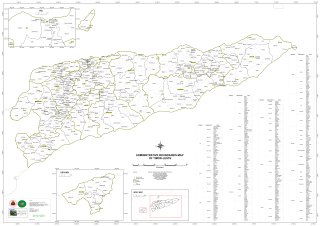
Portuguese Timor was a colonial possession of Portugal that existed between 1702 and 1975. During most of this period, Portugal shared the island of Timor with the Dutch East Indies.

Viqueque is the largest of the municipalities of East Timor. It has a population of 77,402 and an area of 1,877 km2. The capital of the municipality is also named Viqueque.

Cova Lima is a municipality of East Timor, in the Southwest part of the country. It has a population of 59,455 and an area of 1,230 km2. The capital of the municipality is Suai, which lies 136 km from Dili, the national capital.

Same is a town in the Same administrative post in the interior of East Timor, 81 kilometres (50 mi) south of Dili, the national capital. Same has a population of 7,413 and is the capital of Manufahi municipality, which was known as Same District in Portuguese Timor.

The Bunak people are an ethnic group that live in the mountainous region of central Timor, split between the political boundary between West Timor, Indonesia, particularly in Lamaknen District and East Timor. Their language is one of those on Timor which is not an Austronesian language, but rather a Papuan language, belonging to the Trans–New Guinea linguistic family. They are surrounded by groups which speak Malayo-Polynesian languages, like the Atoni and the Tetum.

The Kemak people are an ethnic group numbering 80,000 in north-central Timor island. They primarily live in the district of Bobonaro, East Timor, while the rest live in the East Nusa Tenggara province of Indonesia.

The administrative posts of East Timor are subdivided into 442 sucos ("villages") and 2,336 aldeias ("communities"). Sucos have been part of the country's administrative system since the 20th century, under Portuguese, Japanese, Indonesian, and independent rule.

Fohorem (Fuorém), officially Fohorem Administrative Post, is an administrative post in Cova Lima municipality, East Timor. Its seat or administrative centre is Fohoren.

Luro, officially Luro Administrative Post, is an administrative post in Lautém municipality, East Timor; Luro is also the name of two of its towns.

Tutuala is a village and suco in the subdistrict of Tutuala. It is situated at the extreme eastern end of Timor. Its population at the 2004 census was 3,707. The subdistrict of Tutuala comprises two sucos, including Mehara and Tutuala with the subdistrict administrator residing in Tutuala. The suco of Tutuala comprised four hamlets (aldeia): Ioro, Pitileti, Tchailoro, and Vero. The main Fataluku language areas of the country are in Tutuala, as well as Lautem and Fuiloro.

Matai is a village (suco) located on northeast of Suai in East Timor. It is part of Maucatar Subdistrict, Cova Lima District.

Oecusse, also known as Oecusse-Ambeno and formerly just Ambeno, officially the Special Administrative Region Oecusse-Ambeno, is an exclave, municipality and the only special administrative region (SAR) of East Timor.

Hoholau is a suco in Aileu subdistrict, Aileu District, East Timor. The administrative area covers an area of 16.72 square kilometers and, at the time of the 2010 census, it had a population of 766 people

Suai Airport, officially Commander in Chief of FALINTIL, Kay Rala Xanana Gusmão, International Airport, and also known as Covalima Airport, is an airport serving Suai, in Cova Lima Municipality, East Timor.

Cacavei is a village (suco) in East Timor. It is located in Lospalos sub-district and Lautem district. This village is in between Lospalos town and Iliomar sub-district.

Alas, officially Alas Administrative Post, is an administrative post in the centre of Manufahi municipality, which lies in the centre of East Timor. Its seat or administrative centre is Mahaquidan, and it is divided into five sucos: Aituha, Dotik (Dotic), Mahaquidan, Taitudac und Uma Berloic.

Suai, officially Suai Administrative Post, is an administrative post in Cova Lima municipality, East Timor. Its seat or administrative centre is Camenaça.

Babulo(Babolu) is a settlement in East Timor and a Suco in the Uato-Lari Administrative Post. The Suco is one of the ethnic centers of the Naueti, and is also inhabited by the Makasae, an ethnic minority in the region. The different groups and clans are tightly connected through an ancient social structure which still has a big impact on their society today.
Salele is a village in East Timor located in the suco of Lalawa in the Tilomar Administrative Post of the Cova Lima Municipality. It is the location of the second main border crossing between the East Timor and Indonesia. The checkpoint on the Indonesian side of the border is called the Motamasin checkpoint.

Bidau Santana is a suco in Cristo Rei Administrative Post, Dili Municipality, East Timor. The administrative area covers an area of 1.84 square kilometres and at the time of the 2015 census it had a population of 6,482 people.





















